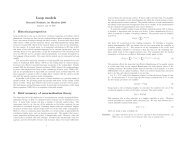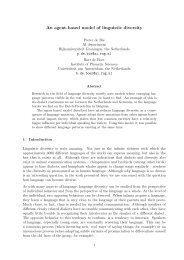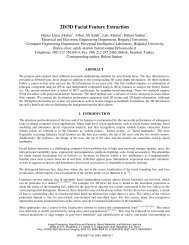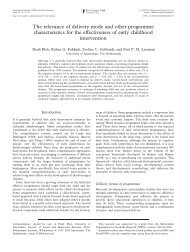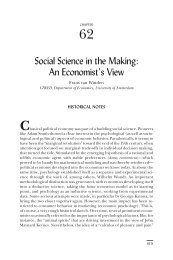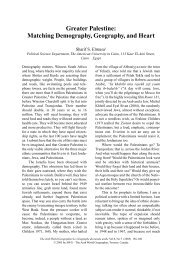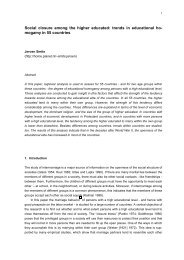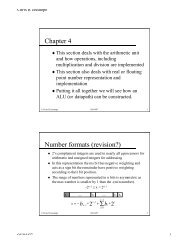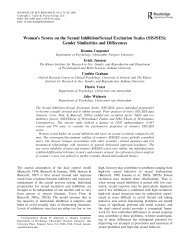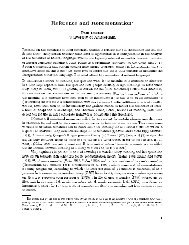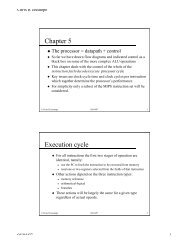Measuring the extent <strong>and</strong> consequences of financing frictions among local banks isparticularly relevant in emerging markets. In first place, financial constraints are more likely <strong>to</strong>be prevalent among local banks, since unlike large foreign banks, these do not have largeinternal capital markets from which <strong>to</strong> draw funding (Berger, Klapper, Miller <strong>and</strong> Udell (2003),Stein (1997)). Also, recent evidence suggests that borrowers of local banks may have little access<strong>to</strong> other sources of funding even when banking markets are open <strong>to</strong> foreign investment (Mian(2006)). As a consequence, shocks <strong>to</strong> the banking sec<strong>to</strong>r can have a disproportionate effect oninvestment by local bank borrowers in emerging markets.The macroeconomic environment in Argentina during the late 90s is particularly suitable forstudying bank liquidity issues. The banking system was operating amidst increasing liquidity <strong>and</strong>stalling investment opportunities. Real GDP grew at an annual average of 0.1% between 1998<strong>and</strong> 2000, while <strong>to</strong>tal bank deposits experienced an average yearly growth of 9.1% during thesame period. These conditions stack the cards against finding evidence of banks beingconstrained in the resources available for investment.B. Testing for Financing <strong>Constraints</strong> of <strong>Bank</strong>sThe empirical literature on the lending channel is focused on providing evidence of thefailure of the Modigliani-Miller (MM) proposition for banks: changes in the financial position ofan unconstrained bank will not affect its lending behavior. The usual empirical specificationlooks at the relationship between loan growth <strong>and</strong> variables that affect bank sources of capital:lnL it - lnL it-1 = α i + α t + β 0 (lnD it - lnD it-1 ) + γx it + ε it(I-1)where L it are <strong>to</strong>tal loans of bank i at month t, D it is a proxy for sources of capital net of reserverequirements, α i (α t ) are bank (month) fixed effects, x it is a set of controls <strong>and</strong> ε it is a s<strong>to</strong>chasticerror term. Under the null hypothesis of no financial frictions, β 0 =0. Changes in sources of7
capital net of reserve requirements are commonly proxied with changes in monetary policy,deposit growth, internal cash, <strong>and</strong> s<strong>to</strong>ck prices (see for example Bernanke <strong>and</strong> Gertler (1995),Hubbard (1995), Jayaratne <strong>and</strong> Morgan (2000), Ostergaard (2001), <strong>and</strong> Peek <strong>and</strong> Rosengren(1997)). The MM argument holds even when insured deposits, priced below the market rate, areused as a source of variation. Changes in deposits are inframarginal <strong>and</strong> do not affect themarginal cost of financing, which is given by market priced sources of financing (e.g.subordinated debt, equity).The main concern with the st<strong>and</strong>ard specification is that the sources of variation in sourcesof capital, D it , are potentially correlated with other fac<strong>to</strong>rs affecting either the supply or thedem<strong>and</strong> of credit. For example, an increase in deposits might decrease the risk profile of thebank <strong>and</strong> reduce the cost of capital, or signal better future lending prospects <strong>and</strong> a highermarginal returns on lending. In both cases, changes in deposits will be correlated with lendingeven when banks are unconstrained. Empirical work has approached this difficult identificationissue several ways: 1) controlling explicitly for bank investment opportunities (Tobin’s q, orGDP growth); 2) looking for larger sensitivities of lending <strong>to</strong> D among banks that are morelikely <strong>to</strong> be constrained according <strong>to</strong> size, equity capital, holdings of liquid assets or otherobservable characteristics (Ashcraft (2006), Kashyap <strong>and</strong> Stein (2000), Kishan <strong>and</strong> Opiela(2000)); <strong>and</strong> 3) by looking at changes in the composition of bank finance within firms whenbanks receive external finance shocks (Gan (2006), Kashyap, Lamont <strong>and</strong> Stein (1994),Kashyap, Stein <strong>and</strong> Wilcox (1993), Khwaja <strong>and</strong> Mian (2005)).Even with these refinements, the link between the observed lending sensitivities <strong>and</strong>financial constraints is not straightforward. Measurement errors in q <strong>and</strong> bank specific changesin investment opportunities may induce a correlation between investment <strong>and</strong> cash flow8
- Page 1: Local Bank Financial Constraintsand
- Page 7: anked second among emerging market
- Page 11 and 12: of the world “when the level of f
- Page 13 and 14: higher proportion of loans in poor
- Page 15 and 16: fungibility. In a recent study of a
- Page 18 and 19: ―15.4% versus 6.3%, and has an av
- Page 20 and 21: The second step is to calculate the
- Page 22 and 23: The CDSF data is used to construct
- Page 24 and 25: I estimate a regression of bank sou
- Page 26 and 27: and strong influence on the financi
- Page 28 and 29: interaction term, β C 0 , represen
- Page 30 and 31: C. Underinvestment or Free Cash Flo
- Page 32 and 33: A potential concern with the previo
- Page 34 and 35: ln(Debt ikt ) - ln(Debt ikt-1 ) =
- Page 36 and 37: program finance are negative, which
- Page 38 and 39: orrower bank debt comes solely from
- Page 40 and 41: Appendix: A Model of Program Partic
- Page 42 and 43: higher region and size point scores
- Page 44 and 45: Bharath, Sreedhar, Sandeep Dahiya,
- Page 46 and 47: Jensen, Michael, 1986, Agency Costs
- Page 48 and 49: Peek, Joe, and Eric Rosengren, 1997
- Page 50 and 51: Figure 1Evidence on Loan Re-Labelin
- Page 52 and 53: Figure 3Kernel Estimation of the Mo
- Page 54 and 55: Table IILoan and Loan Recipient Sum
- Page 56 and 57: Table IVOLS/2SLS Estimates of the E
- Page 58 and 59:
Table VIConstraints or Free Cash Fl
- Page 60 and 61:
Table VIIITesting for Changes in Ba
- Page 62 and 63:
1 For examples of the first line of
- Page 64 and 65:
12 The 2SLS estimates of the sensit



